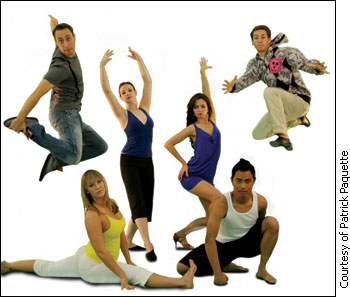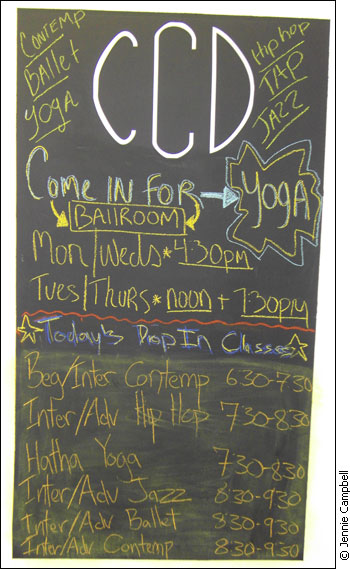Tags
Related Posts
Share This
Ottawa dance gets fresh
Ottawa is full of vibrant dance schools, but the city is more known for technical training than innovation.
It used to be that every little girl in dance dreamed of being a ballerina, with a pink tutu and pink point shoes. But recently, television changed the game.
The dream, inspired by popular shows like So You Think You Can Dance, has evolved to include new styles, new aspirations and a new knowledge of dance.

Not strictly ballroom: Capital City Dance teachers’ various styles.
Ottawa’s dance education community is playing catch-up. Along with various schools looking at providing new courses, a whole new school has just arrived in town that promises to deliver more of what television audiences — including Ottawa students and parents — are looking for.
A new school
Capital City Dance opened in Westgate mall last September. At the helm of this new endeavour are Gabriel Wolinksy and Michael Falcucci. Their aim is to bring “the best of everything to Ottawa.”
“We are a new studio, and dance has changed so much in the last five years; it’s been very commercial, styles have changed, and we’ve been a part of that,” says Falcucci.
Both Falcucci and Wolinsky trained at Greta Leeming Studio of Dance, and left Ottawa to pursue careers as professional dancers. Since then, they have kept busy with shows like Cats, We Will Rock You, Oliver and Hello Dolly, and they danced together in the national Broadway tour of Dirty Rotten Scoundrels. They have experienced what bigger cities like Toronto offer in terms of classes, workshops and styles, and they are bringing that to Ottawa.
“We are a new studio, and dance has changed so much in the last five years, and we’ve been a part of that.” — Michael Falcucci, Capital City Dance school
“I feel like [Ottawa is] known as having good technical dancers out there. I want people to realize that Ottawa also has creative people, people that can really step outside the box and can make a difference in dance in general,” says Falcucci. “I think people here have the ability to do so. We are just wanting to give them the tools to realize that.”
New styles — like contemporary, zumba, ballroom and step dancing — aren’t the only tools that Capital City Dance provides. It also has a stronger focus on workshops, which bring dance professionals from other cities to Ottawa.
“Bringing people who have worked with Michael Jackson and amazing choreographers from all over the world to Ottawa is just giving a dancer another tool, an extra edge,” says Wolinsky.
For the first time in Ottawa, that “edge” is in demand.
The television effect
“So You Think You Can Dance has been huge for dance in general just because it is putting it on a main stage and exposing dance in a way that it never really has been before,” says Brianna Rowan, who has been dancing at the Canadian School of Dance for the past 18 years.
Tami-Lynn Caloia, co-director of Greta Leeming Studio of Dance, agrees. She has been teaching in Ottawa for 24 years and says that popularity of dance has risen and parents are more aware than ever of what makes a good dancer.
“They want to make sure that their kids are getting what they should be getting, whereas before I think parents kind of just dropped their kids at the door,” she says.

A Capital City Dance chalkboard shows the school’s range.
Greta Leeming, too, is looking at implementing new styles in its curriculum. The school did workshops of new styles in its summer program, says Caloia. Latin dance, ballroom and disco all proved to be popular with students.
“You have to keep current,” she says. “For me, I have to watch all those shows, go to conventions and learn from my graduates that have left and come back.”
Caloia says that while the new styles are getting more popular, it is still essential to be true to basic training and to proper teaching, as well.
It’s hard for dancers in Ottawa, adds Caloia, because in order to pursue a professional dance career after high school, you have to move to Toronto.
But for those who are learning in the capital city, Ottawa is developing more options.
In the past year, Rowan’s younger sister, Mallory, who trains at the Canadian School of Dance, has embraced those new opportunities. She has joined hiphop troupes Future Shock and dTALE, participates in workshops at other studios and takes classes at Capital City Dance.
Mallory Rowan says that it’s not just the teachers but the students who have to make the effort to branch out.
“In Ottawa, a lot of people tend to complain that there are not enough classes they can take. But the thing is when people are with a studio or with a crew, sometimes they don’t branch out and then they don’t realize that there are classes like this.”
New styles, new options
With dance being as popular as it is, there is a unique opportunity for Ottawa dance students to grow.
“Everybody, no matter who they are, brings something different with respect to choreography, how they train you,” says Caloia. “I think for a dancer, you just soak it in and you can apply that to your regular dancing. I think the exposure to different things makes you better.”
That open attitude is exactly what Ottawa needs, and what Capital City Dance hopes to thrive on. Wolinsky explains that “you can’t always stay in the box: if you stay in the box you are only going to grow as big as a box. So you have to step out of that and you have to learn new things.”
Related Links





